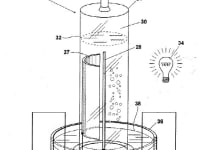
To date, hydrogen generation for fuel cells has required electricity generated by burning fossil fuels or inefficient solar cells. This invention (US Patent 6,843,903) enables electrolysis of water using the energy of solar photons to partially replace the energy of the applied current.
While most solar photons do not have the energy to split water into hydrogen and oxygen, in this process the photons assist a lower than normally required potential between the anode and cathode in an application of the photoelectric effect. The energy of the emitted electron is increased by an electric field imposed between the cathode and the anode. The large surface area of the cathode is treated to form a finely divided metal 'black' coating to enhance photon absorption and hydrogen generation. The anode is a series of thin wires between the cathode and light source which provide current without blocking significant light. A transparent barrier between them allows separation of generated hydrogen and oxygen.
The high efficiency of the incident photon use (>40% demonstrated) when combined with an efficient fuel cell has the option of storing energy in the form of either hydrogen or batteries when the sun is unavailable. It is ideal for remote or mobile electrical generation especially in rural or third world applications.
The illustrations:
Figure 5 is a simplified concept example (no gas separation) in which the cathode (#27), the anode (#28), the water is made conductive by addition of a salt such as sodium sulfate. The cathode is formed from a thin sheet of copper coated with electro-deposited nickel to form a light absorbent coating or “black” on the side facing the anode and light source. Other materials are possible. Figures 3 and 4 illustrate a more practical embodiment shown in cross-section in Figure 3 and frontal view in Figure 4. In these illustrations #42 indicates the anode wires, #48 is the cathode sheet, #44 the transparent barrier between the electrodes and #40 a transparent covering facing the light source.
-
Awards
-
 2012 Top 100 Entries
2012 Top 100 Entries
Like this entry?
-
About the Entrant
- Name:A. Nicholas Roe
- Type of entry:individual
- Patent status:patented








